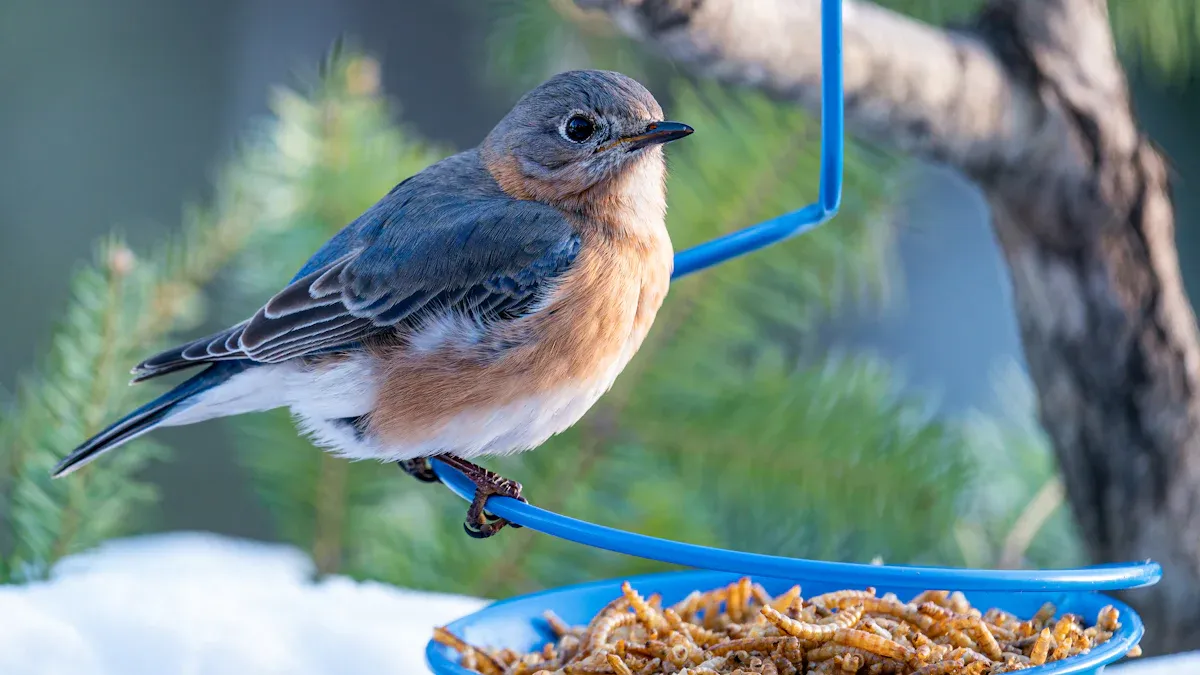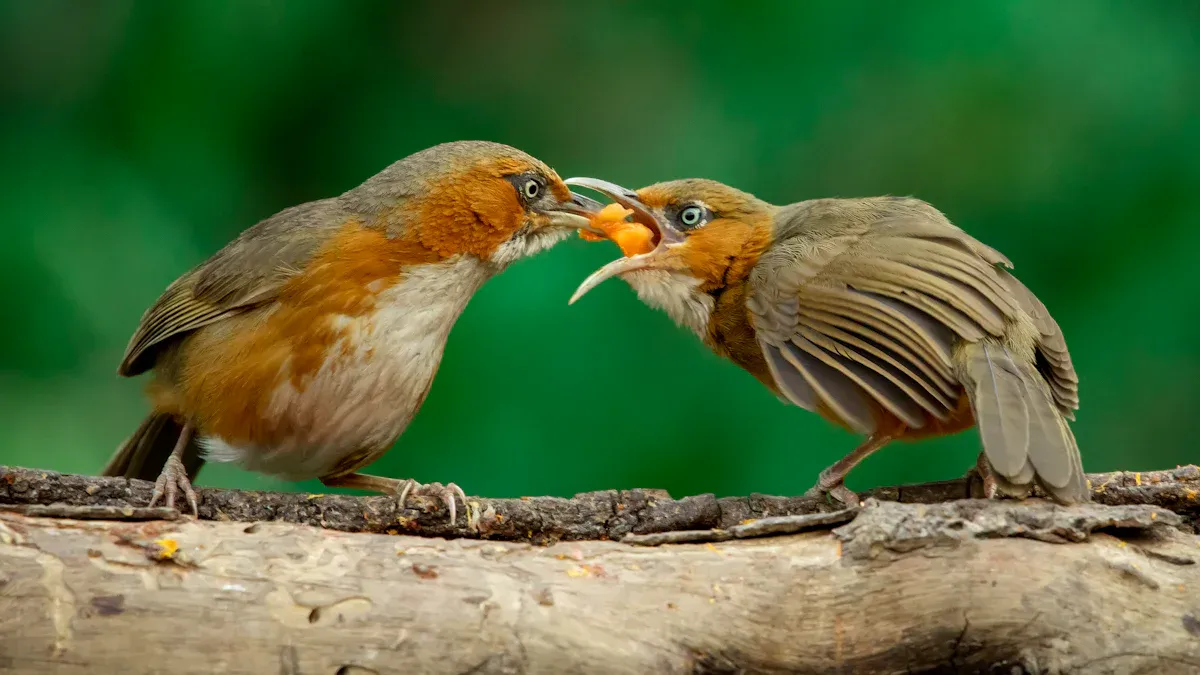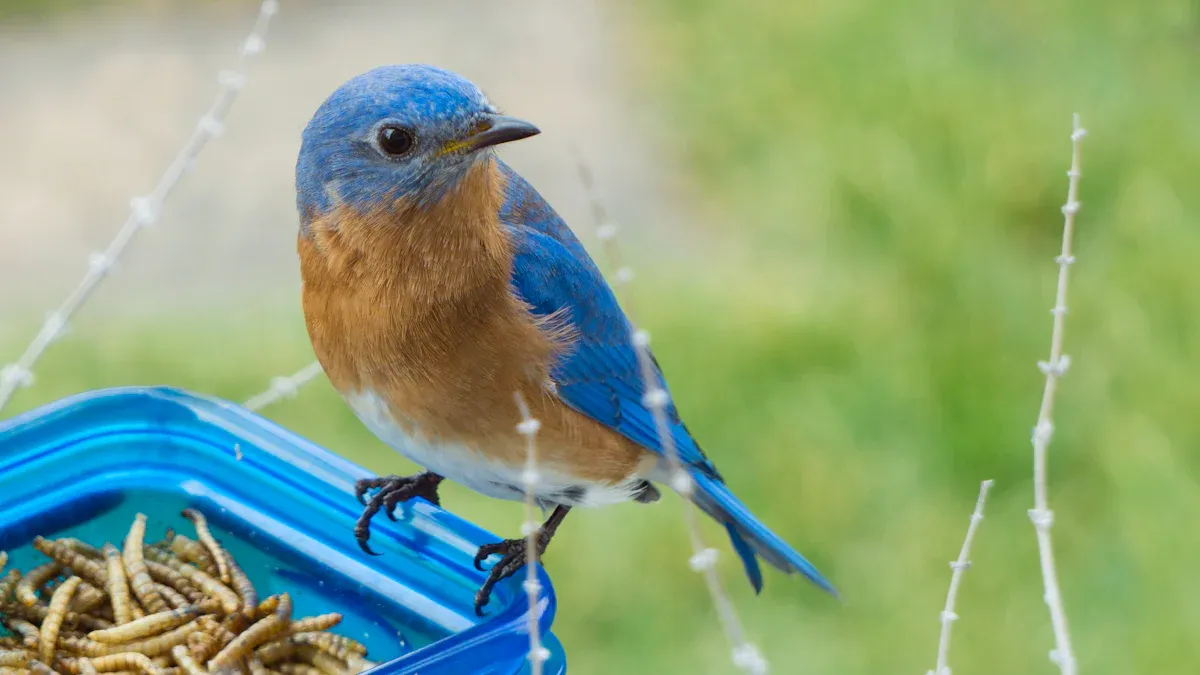
Wild birds thrive on mealworm protein, a nutrient-packed food that boosts their health. Mealworms offer exceptional nutrition: live ones contain 20% protein and 13% fat, while dried ones provide 53% protein and 28% fat. These values make mealworms a powerhouse for energy and vitality, especially during breeding, molting, or harsh weather.
Key Takeaways
- Mealworms are a healthy food for wild birds. They give birds protein and fat, which help them stay strong, especially when breeding or in bad weather.
- Using both live and dried mealworms can bring many bird types. Live mealworms are better because they move, but dried ones are easy to use and full of protein.
- Storing and feeding mealworms the right way is important. Keep them fresh by using clean feeders, checking for rot, and storing them in cool, dry spots.
Benefits of Mealworm Protein for Wild Birds

Nutritional Value of Mealworms
Mealworms are a rich source of essential nutrients that support wild birds’ health. They contain high levels of protein and fat, which are vital for energy and growth. A breakdown of their nutritional profile reveals their value:
| Nutrient | Percentage (%) |
|---|---|
| Moisture | 72 |
| Ash | 5 |
| Lipid | 19 |
| Protein | 51 |
| Chitin | 8 |
| Non-fiber carbohydrate | 18 |
These nutrients make mealworms an excellent supplement for wild birds, especially during demanding life stages. While they may not surpass the nutritional value of natural insects, mealworms can be enhanced with nutritional powders to meet the needs of young or growing birds.

Supporting Birds During Breeding and Molting
Breeding and molting are energy-intensive periods for wild birds. Mealworm protein provides the necessary building blocks for feather regeneration and egg production. The high protein content, particularly in dried mealworms (53%), ensures that birds have the resources to thrive during these critical times. Additionally, the fat content in mealworms supports sustained energy levels, helping birds remain active and healthy.
Benefits in Harsh Weather and Food Scarcity
During winter or periods of food scarcity, mealworms become a lifeline for wild birds. Their high-fat content (13% in live mealworms and 28% in dried mealworms) helps birds maintain body heat in cold conditions. The protein in mealworms also supports young birds, laying females, and chicks when natural food sources are limited.
| Nutrient | Live Mealworms | Dried Mealworms |
|---|---|---|
| Moisture | 62% | 5% |
| Lipid (Fat) | 13% | 28% |
| Protein | 20% | 53% |
| Ash | 1.5% | 4.1% |
| Carbohydrate | 3.1% | 8.5% |

Mealworm protein ensures that wild birds can endure challenging conditions and emerge stronger. By offering this nutrient-rich food, bird enthusiasts can play a vital role in supporting their survival and well-being.
How to Feed Wild Birds with Mealworms
Live vs. Dried Mealworms
Bird enthusiasts often wonder whether live or dried mealworms are better for feeding wild birds. Both options have unique benefits. Live mealworms provide a more natural feeding experience. Their movement attracts birds, making them irresistible to species like bluebirds and robins. They also contain higher moisture content, which helps hydrate birds, especially in dry conditions.
Dried mealworms, on the other hand, are convenient and long-lasting. They require no maintenance and can be stored easily. Their high protein content makes them a reliable source of energy during breeding or harsh weather. For the best results, bird lovers can offer a mix of both types to cater to different needs and preferences.
Tips for Making Mealworms Appealing
Some birds may hesitate to try mealworms at first. To make them more appealing, place mealworms in a shallow dish or tray feeder where birds can easily spot them. Sprinkling mealworms near existing feeders or bird baths can also encourage curiosity.
Adding mealworms to a mix of seeds or suet can attract a wider variety of birds. For dried mealworms, soaking them in warm water for a few minutes rehydrates them, making them more enticing. Patience is key—once birds discover mealworms, they will return for more.
Safe Feeding Practices
Feeding wild birds responsibly ensures their health and safety. Always use clean feeders to prevent the spread of disease. Avoid overfeeding, as leftover mealworms can attract pests. For live mealworms, keep them in a secure container to prevent escape.
Place feeders in shaded areas to protect mealworms from spoiling in the sun. Regularly check and replace uneaten mealworms to maintain freshness. By following these practices, bird enthusiasts can create a safe and welcoming environment for their feathered visitors.
Choosing Feeders for Mealworm Protein
Features of Effective Mealworm Feeders
Selecting the right feeder ensures birds can enjoy mealworm protein safely and conveniently. Effective feeders share several key attributes that enhance their functionality and protect the food.
| Attribute | Description |
|---|---|
| Sides tall enough | Prevents mealworms from crawling out of the feeder. |
| Roof or rain guard | Protects mealworms from rain, preventing drowning or mold. |
| Drainage holes | Allows any water that enters to drain out, keeping the mealworms dry. |
| Tamper-resistant features | Helps keep the food safe from squirrels and other pests. |
| Deep ledge | Ensures mealworms cannot escape easily. |
| Suitable for hanging | Many bird feeders can be adapted for mealworms, especially with lids. |
These features not only keep mealworms fresh but also make the feeder more appealing to birds. A well-designed feeder can significantly improve bird visitation rates.
Types of Feeders for Mealworms
Bird enthusiasts can choose from various feeder types to suit their needs. Each type offers unique advantages:
- Tray Feeders: Simple and versatile, these feeders allow easy access for birds.
- Hanging Feeders: Ideal for keeping mealworms safe from ground predators.
- Covered Feeders: Equipped with roofs or baffles, these feeders protect mealworms from rain and moisture.
- Specialized Mealworm Feeders: Designed specifically for mealworms, these feeders often include tall sides and drainage holes to prevent escape and spoilage.
Choosing the right type depends on the bird species in the area and the feeder’s placement.
Placement Tips for Maximum Attraction
The location of a feeder plays a crucial role in attracting birds. Placing feeders near shrubs or trees provides birds with a sense of security. Open spaces allow birds to spot the feeder easily. Avoid areas with heavy foot traffic to minimize disturbances.
Positioning feeders at varying heights can attract different bird species. For example, bluebirds prefer feeders closer to the ground, while finches and chickadees enjoy elevated spots. Regularly moving the feeder can also prevent pests from becoming a problem.
By considering these tips, bird enthusiasts can create an inviting environment that encourages wild birds to return for mealworm protein time and again.
Storing Mealworms Safely
Proper storage of mealworms ensures their quality and safety, whether dried or live. By following best practices, bird enthusiasts can provide fresh and nutritious food for their feathered visitors.
Proper Storage for Dried Mealworms
Dried mealworms require a dry, cool, and well-ventilated area for storage. Exposure to moisture can lead to mold, while excessive heat may degrade their nutritional value. Airtight containers work well to keep them fresh and prevent pests from accessing the food. Placing the container in a shaded spot or a pantry helps maintain a consistent temperature.
For long-term storage, freezing dried mealworms is an excellent option. This method preserves their quality and prevents spoilage. Before feeding, allow them to return to room temperature to ensure birds enjoy them at their best.
Storing Live Mealworms
Live mealworms need special care to stay healthy and active. A large, shallow container with smooth sides works best to prevent them from escaping. Plastic or glass containers are ideal, as they resist moisture and are easy to clean. Add 2-3 inches of bedding, such as cornmeal or bran meal, which doubles as food.
Fresh vegetables like raw potatoes or carrots provide essential moisture and nutrients. A gel water source can also be used to prevent drowning. Keep the container in a refrigerator at 45-50°F to slow their metabolism and extend their lifespan. Remove them weekly to feed at room temperature before returning them to refrigeration.
Preventing Spoilage and Contamination
Spoiled mealworms can harm birds, so proper handling is crucial. Always check for signs of mold, unpleasant odors, or discoloration before feeding. For live mealworms, clean the container regularly to remove waste and uneaten food.
Avoid storing mealworms near strong-smelling substances, as they can absorb odors. Label containers with the storage date to track freshness. By taking these precautions, bird enthusiasts can ensure their mealworms remain safe and nutritious for their avian friends.
Birds That Love Mealworm Protein

Common Bird Species That Eat Mealworms
Mealworms are a favorite treat for many wild birds. Species like bluebirds, robins, and chickadees eagerly consume them. Woodpeckers and wrens also enjoy this protein-rich food. Even insect-eating birds like nuthatches and warblers find mealworms irresistible. These birds rely on insects as a natural part of their diet, making mealworms an excellent supplement. Observing these vibrant species flock to feeders can bring joy to any bird enthusiast.
Attracting Birds with Mealworms
Attracting birds with mealworms requires thoughtful strategies. Offering small quantities of mealworms ensures freshness and prevents waste. During spring, increasing the feeding frequency supports birds’ protein needs for egg-laying and feeding their young. Placing mealworms in visible feeders or near bird baths can spark curiosity. Soaking dried mealworms in water makes them more appealing. Since 80% of bird families worldwide include insects in their diets, mealworms naturally draw a wide variety of species.
Creating a Bird-Friendly Habitat
A welcoming habitat encourages birds to visit and stay. Planting native shrubs and trees provides shelter and natural food sources. Adding water features like bird baths or small fountains creates a refreshing environment. Positioning feeders in safe, shaded areas protects birds from predators. Avoiding pesticides ensures a healthy ecosystem for birds and their insect prey. By creating a bird-friendly space, enthusiasts can enjoy the beauty of wild birds while supporting their well-being.
Mealworms offer wild birds essential nutrients, especially when natural insects are scarce. They attract diverse species, enriching gardens and birdwatching experiences.
Feeding mealworms is simple and rewarding. Start today to support wild birds’ health and create a vibrant, bird-friendly habitat. Witness the joy of nature right in your backyard! 🐦
FAQ
How often should mealworms be offered to wild birds?
Feeding mealworms once or twice daily works well. During breeding or winter, increase frequency to support birds’ energy and nutritional needs.
Can mealworms attract unwanted pests?
Yes, leftover mealworms may attract pests. Use feeders with tamper-resistant features and clean them regularly to maintain a safe feeding environment.
Are mealworms suitable for all bird species?
Mealworms appeal to insect-eating birds like bluebirds, robins, and wrens. They may not attract seed-eating species but can complement their diet.
🐦 Tip: Start small when introducing mealworms. Birds may take time to recognize them as food, but patience pays off with rewarding birdwatching moments!


